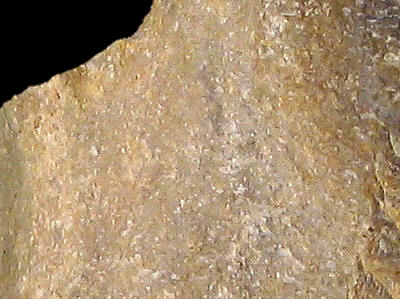
Foto: Jehanne Féblot-Augustins, 2005.
- Breignes-Pierre-Feu 2
- Le Grangeon 1
Sampled sites:
| Material name: | Ht1 |
| Synonyms: | N/A |
| Material (geologic): | Late Hauterivian (Lower Cretaceous) flint |

Foto: Jehanne Féblot-Augustins, 2005. |
Sampled sites:
|
| Mode of occurrence: | Discontinuous beds 6 cm thick when in primary context; angular fragments when in secondary context. |
| Cortex: | Either rough, very light grey brown, 0.5 to 1 cm thick, transition gradual; or worn pale tan neo-cortex <1 mm. |
| Colour: | Greysih brown (10YR 5/2). |
| Pattern: | Featureless. |
| Appearance: | Homogeneous material, dull and opaque, a little rough and medium-grained. |
| Structure: | Faint fluidal arrangement of grains, a few micro-vugs. |
| Texture: | Wackestone/packstone. |
| Matrix: | Subtranslucent to translucent. |
| Grains: | 30 to 40 %, pale yellow to orangey yellow, subangular to rounded and irregularly shaped, poorly sorted (100 to 600 µ), main grain size 400 to 600 µ |
| Grain composition: | Characterization depending on the degree of micritization (peloids); entrochi, echinoderm, bryozoan and pelecypods fragments, rare sponge spicules, globose or cone-shaped biserial foraminifera (Textularidae); clasts, abundant traces of glauconite, iron oxides. |
| Further information: | Click here for the original French description (opens in a new window), or here for more information on the attributes used in the description (use your browser's "BACK"-button to return here). |
| Citing: | Information on citing this page can be found here. |
| Locality: | Poncin / Breignes - Pierre-Feu 2, France, Ain department |
| Synonyms: | Sampling site Bugey 34 after Féblot-Augustins |
| Geographical description: | The source is located near a narrow road/path on a slight rise between the hamlets of Chenavel and Breignes, a bit over half a kilometre to the west of the latter, and somewhat more than 2 kilometres SSE of Poncin. |
| Geographical co-ordinates: |
east/x 838.2 north/y 2122.9 (Lambert zone II, NTF)
This corresponds with |
| Co-ordinate precision: |
The Lambert-coordinates given were read from a detailed topographical map, and are within 50 metres of the precise location. The latitude/longitude coordinates are a direct transformation of these data on WGS84 and have the same accuracy. They are given to the apparent high accuracy to prevent the introduction of a rounding-error. The location can be found on the 1:25 000 topographical map sheet 3230 W of the French Institut Géographique National. |
| Geology: |
The embedding materials are, according to the geological map, Late Miocene (Tortonian) continental sediments, belonging to the stratigraphic unit m2bC. The reworked flints themselves seem to originate from Lower Cretaceous (Late Hauterivian) limestones. Map of all sampled localities of Early Cretaceous flint in the Bugey (PDF, 300 KB, opens in new window). |
| Type of source: | Secondary. |
| Other types of flint: | Apart from the Early Cretaceous Ht1-type, other Cretaceous flints of the types CN1a, CN2a and CN8c can be found here, as well as the Middle Jurassic Bt material. |
thumb.jpg) Foto: Jehanne Féblot-Augustins, 2005 |
| Locality: | Arbignieu / Thoys - Le Grangeon 1 |
| Synonyms: | Sampling site Bugey 44 after Féblot-Augustins |
| Geographical description: | N/A |
| Geographical co-ordinates: |
east/x 857,3 north/y 2087,45 (Lambert zone II, NTF)
This corresponds to |
| Co-ordinate precision: |
The coordinates given were taken from a large-scale map, and are within 50 metres of the actual spot. The latitude/longitude coordinates are a direct transformation of these data on WGS84 and are accurate to the same level, so don't be deceived by the apparently high precision to the second. The location can be found on the 1:25 000 topographical map sheet 3231 E of the French Institut Géographique National. |
| Geology: |
According to the geological map, the substrate belongs to unit n3 of Hauterivian age. Map of all sampled localities of Early Cretaceous flint in the Bugey (PDF, 300 KB, opens in new window). |
| Type of source: | Primary. |
| Other types of flint: | Apart from the Ht1-type, no other materials are known from this exposure. |
thumb.jpg) Foto: Jehanne Féblot-Augustins, 2005 |
thumb.jpg) Foto: Jehanne Féblot-Augustins, 2005 |
| Last modified on: November 15, 2005 |
Contents primarily by: Jehanne Féblot-Augustins |
Comments to: |